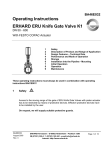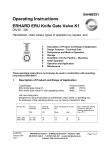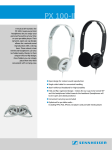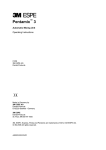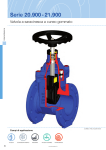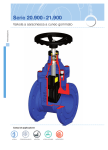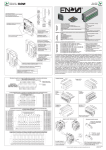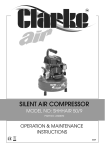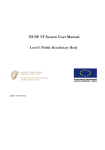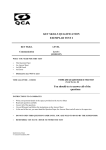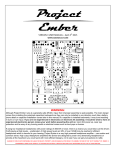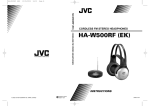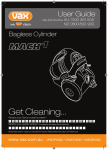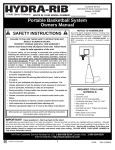Download Operating Instructions
Transcript
BA46E033 Operating Instructions ERHARD ERU Knife Gate Valve K1 DN 50 - 300 Electric Actuator 1 2 3 4 5 6 7 8 9 Safety Description of Product and Range of Application Design Features – Technical Data Performance and Mode of Operation Storage Installation into the Pipeline - Mounting Initial Operation Operation Maintenance These operating instructions must always be used in combination with operating instructions BA01E001! 1 Safety Access to the range of movement of the gate of ERU Knife Gate Valves with electric actuator has to be restricted by protective devices. Effective protective devices have to be installed by the user. On request, we will supply suitable protective guards. 2 Description of Product and Range of Application Type/Design ERU Knife Gate Valve K1 ERU Knife Gate Valve K1 with regulating orifice Product Number 4657 PN 10 4623 PN 10 Design with electric actuator BA46E033 July 2005 Rev. 4 ERHARD-Armaturen x D-89502 Heidenheim x Postfach 1280 (07321) 320-0 (07321) 320 491 e-mail:[email protected] Internet: http://www.erhard.de Page 1 of 13 Operating Instructions for ERU Knife Gate Valve K1 with electric actuator Product No. 4655, 4656 4657, 4623 Nominal diameter Nominal pressure DN PN 50 - 300 50 – 300 10 10 Hydr. test pressure in bars for Body Seat 15 15 10 10 Max. admissible working pressure in bars at a working temperature of max. 70° C 10 10 If EPDM profile seals are used for the ERU Knife Gate Valves K1, the parts of EPDM must not get in contact with oil or grease, as the EPDM would swell. For a recommended lubricant see section "Maintenance". ERU Knife Gate Valves K1 of this design are suitable for "ON-OFF" operation. For explicit regulating service, special designs have to be used, e.g. design with regulating orifice. BA46E033 July 2005 Rev. 4 ERHARD-Armaturen x D-89502 Heidenheim x Postfach 1280 (07321) 320-0 (07321) 320 491 e-mail:[email protected] Internet: http://www.erhard.de Page 2 of 13 Operating Instructions for ERU Knife Gate Valve K1 with electric actuator 3 Design Features – Technical Data Drawing 2E 39861 ERU Knife Gate Valve K1 with electric actuator BA46E033 July 2005 Rev. 4 ERHARD-Armaturen x D-89502 Heidenheim x Postfach 1280 (07321) 320-0 (07321) 320 491 e-mail:[email protected] Internet: http://www.erhard.de Page 3 of 13 Operating Instructions for ERU Knife Gate Valve K1 with electric actuator Dimensioned table (for drawing No. 2E 39861) 1) ²) 3) PREFERRED SERIES FOR MODULATING ACTUATORS PREFERRED SERIES FOR STANDARD ACTUATORS EN558-1, BASIC SERIES 20 FORMER DIN 3202, PART 3, SERIES K1 BA46E033 July 2005 Rev. 4 ERHARD-Armaturen x D-89502 Heidenheim x Postfach 1280 (07321) 320-0 (07321) 320 491 e-mail:[email protected] Internet: http://www.erhard.de Page 4 of 13 Operating Instructions for ERU Knife Gate Valve K1 with electric actuator Parts lists and sets of spare parts (for drawing 2E 39861) 1. 2. 3. 4. Replace profile seal Replace U-shaped sealing element Replace stem Replace stem nut Item 1 2 3 4 5 6 7 8 9 10 11 12 13 14 15 16 17 18 19 20 21 22 23 24 25 26 27 28 29 BA46E033 July 2005 Rev. 4 Description Body component Sealing element Hexagon bolt Washer Hexagon nut Gate Profile seal Guide tape Compressor Taper plug Cover plate Washer Hexagon bolt Bush Fork nut Bolt Washer Cotter pin Stem Straight grooved pin Stud bolt Gudgeon Bearing support Washer Hexagon nut Electric multi-turn actuator Washer Cylindrical screw Taper plug Set1 Set2 Set3 Set4 every 2 years every 5 years if necessary if necessary Set1 Set2 Set3 Set4 X X X X X X X X ERHARD-Armaturen x D-89502 Heidenheim x Postfach 1280 (07321) 320-0 (07321) 320 491 e-mail:[email protected] Internet: http://www.erhard.de Page 5 of 13 Operating Instructions for ERU Knife Gate Valve K1 with electric actuator 4 Performance and Mode of Operation ERU Knife Gate Valves K1 are wafer-type single-door gate valves with short face-toface dimension. A special type of these valves, e.g. with regulating orifice, is also suitable for regulating purposes. The solid gate slides in a long gate guide between two body components. It seals on its periphery against a rubber-resilient, steelreinforced, enclosed U-shaped sealing element. Where the gate leaves the body, tightness to the outside is ensured by a resiliently prestressed profile seal which can be readjusted. For reducing wear and tear of the profile seal and the actuating elements the prestress can be reduced to the dimension required for the actual operating pressure. The Gate Valves were tested for tightness and resistance to DIN EN12266 and DIN EN1074 at the manufacturer's plant. They are designed for flow acting from any direction. ERU Knife Gate Valves K1 are disconnected in a travel-dependent manner in closing and opening directions. The limit positions "OPEN" and "CLOSED" are signalled by the travel switches. Running against or jamming at the upper mechanical stop of the valve due to motor after-running is avoided. The torque switches serve as safety switches in opening and closing directions. ERU Knife Gate Valves K1 are switched in a travel dependent manner in closing and opening directions. 4.1 Retrofitting of an Electric Multi-Turn Actuator If the valve is supplied without incorporated electric actuator, the torque and travel switches have to be set as follows after mounting the electric actuator: 4.1.1. Move the valve manually in central position and check the direction of rotation of the motor by means of short switching impulses - if necessary, change the poles of the motor connection. The valve closes when turning the handwheel in clockwise direction. 4.1.2. Set the torque switches to the torques specified in the enclosed drawings. 4.1.3. Move the valve manually in open position against the upper mechanical limit stop. Then, move the handwheel by 10 turns in closing direction and adjust the "OPEN" travel switch. 4.1.4. Move the valve manually in closed position and adjust the "CLOSED" travel switch. BA46E033 July 2005 Rev. 4 ERHARD-Armaturen x D-89502 Heidenheim x Postfach 1280 (07321) 320-0 (07321) 320 491 e-mail:[email protected] Internet: http://www.erhard.de Page 6 of 13 Operating Instructions for ERU Knife Gate Valve K1 with electric actuator Electrical connection has to be effected according to Operating Instructions as well as wiring and terminal diagrams of the electric actuator's manufacturer (travel, torque and thermal switches, heating, motor). Before installation, the insulating resistance of the motor must be measured. If it is lower than 500 K-ohms, this shows that the winding is moist. The motor has to be removed in order to be dried up and it must be heated by means of a hot-air fan or in a heating chamber: max. admissible temperature 100°C. 4.2 Commissioning of the Electric Actuator 4.2.1. Move the ERU Knife Gate Valve K1 manually to central position. 4.2.2. Check the gate movement and thus the direction of rotation of the actuator by short electrical starting. + Valve is closing = CLOCKWISE direction of actuator rotation Valve is opening = ANTI-CLOCKWISE direction of actuator rotation 4.2.3 In case of wrong direction of rotation, change poles of motor connection. 4.2.4 Check direction of rotation by short electrical starting. 4.2.5 Check correct switching sequence of the torque switches in "Open-Close" direction by manual operation. 4.2.6. Change poles if necessary. 4.2.7. Move the valve over the whole travel only if the direction of rotation for closing the valve is CLOCKWISE. + In case of wrong direction of rotation, travel and torque switches are ineffective! BA46E033 July 2005 Rev. 4 ERHARD-Armaturen x D-89502 Heidenheim x Postfach 1280 (07321) 320-0 (07321) 320 491 e-mail:[email protected] Internet: http://www.erhard.de Page 7 of 13 Operating Instructions for ERU Knife Gate Valve K1 with electric actuator 4.3 Jogging Operation and Manual Emergency Operation Note: before start-up spindle and spindle nut are to be greased. (recommended lubricant see section “Maintenance”) Attention: If a foreign body is jammed in when operating the valve, the torque switch for the corresponding direction responds and switches off the motor. The time lag between response of the torque switch and disconnection of the motor from the network depends on the signal delay. If another closing order is given in the original direction, without having moved the valve sufficiently in the opposite direction, the torque will increase. If this procedure is repeated several times, the torque will accumulate. The valve and its operating elements are not designed for such an emergency and might be damaged. + We explicitly draw your attention to the fact that such "jogging operation" is inadmissible. Jogging operating is admissible under the following conditions: If the torque switch responds in intermediate position, the valve must first be moved in the opposite direction until the torque switch completley returns to its original position. Only now the valve may be moved again in the direction in which the disturbance occurred. Proceeding this way, you will obtain torques corresponding to the torques set at the torque switch. Moreover, the foreign matter can come off and be flushed out of the seating zone. Operation by emergency handwheel: If the valve is operated by means of the handwheel of the electric actuator, the torque switches do not provide any safety function. If a foreign body is jammed with the valve being in intermedite position, excessive operating force - particularly in case of high gear reduction - might be damaging to the drive components. Therefore, we draw your attention to the following fact: If any resistance is detected during emergency handwheel operation, some turns must be made in the opposite direction before the handwheel is turned again in the direction in which the disturbance occurred (flush out the foreign body). Continue operation with utmost care, in no case using excessive force. If need be, repeat flushing operation. BA46E033 July 2005 Rev. 4 ERHARD-Armaturen x D-89502 Heidenheim x Postfach 1280 (07321) 320-0 (07321) 320 491 e-mail:[email protected] Internet: http://www.erhard.de Page 8 of 13 Operating Instructions for ERU Knife Gate Valve K1 with electric actuator 5 Storage Store ERU Knife Gate Valves K1 in their closed position. Rubber-coated components, as e.g. the sealing element between the body parts, have to be protected against direct solar radiation. Avoid the effects of radiant heat, e.g. from heaters. 6 Installation into the Pipeline Remove all packing material from the valve. Prior to installation, check the pipeline for impurities and foreign bodies and clean it if necessary. + There must be free access all around the valve for operation and maintenance. In case of flow media containing solid matters as e.g. sand etc. and installation into horizontal pipelines the stem or the piston rod should not be installed with an inclination of more than 30º towards the horizontal. Thus, free flushing of the travel range of the gate is possible. In case of deviating installation positions, especially with suspended stem or piston rod, deposits around the gate have to be expected. This could lead to mal-functions which increase maintenance work. During installation of the valve, the distance between the pipe flanges should exceed the valve face-to-face dimension by at least 20 mm. Thus, the raised faces will not be damaged and the gaskets can be inserted. Steel-reinforced rubber seals to DIN 2690 are recommended for use as flange gaskets, for slip-on flanges they are absolutely necessary (consider resistance to flow medium and temperature). The mating pipe flanges must be plain-parallel and concentric. Tighten the connecting bolts evenly (without distortion) and crosswise. The pipeline mustn't by any means be pulled up to the valve. If the distance between the flanges is too large for the valve, use thicker gaskets to cover the difference. BA46E033 July 2005 Rev. 4 ERHARD-Armaturen x D-89502 Heidenheim x Postfach 1280 (07321) 320-0 (07321) 320 491 e-mail:[email protected] Internet: http://www.erhard.de Page 9 of 13 Operating Instructions for ERU Knife Gate Valve K1 with electric actuator ERU Knife Gate Valves K1 are - clamped between two flanges of the pipeline (wafer type) or - screwed to the end flange of the pipeline as end-of-line valves. The screwed connection with the pipeline is made from flange to flange by means of bolts in the through-going holes. For the threaded blind holes the screwed connection is made by means of stud bolts or bolts in the body components. It is possible to roughly fasten the valve by means of the threaded holes. The necessary connecting elements for the corresponding installation position are shown in drawing No. 4E127 920. BA46E033 July 2005 Rev. 4 ERHARD-Armaturen x D-89502 Heidenheim x Postfach 1280 (07321) 320-0 (07321) 320 491 e-mail:[email protected] Internet: http://www.erhard.de Page 10 of 13 Operating Instructions for ERU Knife Gate Valve K1 with electric actuator Connecting elements for flange connection (to drawing 4E127920) BA46E033 July 2005 Rev. 4 ERHARD-Armaturen x D-89502 Heidenheim x Postfach 1280 (07321) 320-0 (07321) 320 491 e-mail:[email protected] Internet: http://www.erhard.de Page 11 of 13 Operating Instructions for ERU Knife Gate Valve K1 with electric actuator 7 Initial Operation After installation, the valve has to be checked for smooth operation. It has to be moved at the operating element over the whole travel (OPEN-CLOSED). In case of lower working pressures, after having carried out the pressure test of the pipeline, the profile seal can be released to be adapted to the effective working pressure. For this purpose, the bolts on the cover plate have to be loosened in an appropriate manner. By means of this measure you can reduce wear and tear of the components involved in the motion. ATTENTION! The flow medium may penetrate. Wear safety clothing (safety goggles) in case of toxic or caustic media. 8 Operation Trouble Possible Causes Remedy Leakage at the cover plate Prestress too low Readjustment of cover plate see paragraph “9 Maintenance“ Wearing of the profile seal Replace profile seal Contamination (deposit on the gate) With valve in open position: clean and grease gate Contamination of the gate With valve in open position: clean and grease gate Defective U-shaped sealing element Replace sealing element Contamination (deposit) on the gate With valve in open position: clean and grease gate Stem running dry Regrease thread Residues of flow medium are hardened Relieve pipe section from pressure. Clean and grease all accessible surfaces of gate and stem. Slacken cover plate. Slightly unscrew upper body bolts. Knock on the valve with a rubber mallet trying to operate the valve. If you are not successful: remove, dismantle, clean, replace damaged parts. Foreign bodies jammed in the seating zone Move valve in OPEN position and repeat closing procedure Seat leakage Excessive operating forces Operation blocked BA46E033 July 2005 Rev. 4 ERHARD-Armaturen x D-89502 Heidenheim x Postfach 1280 (07321) 320-0 (07321) 320 491 e-mail:[email protected] Internet: http://www.erhard.de Page 12 of 13 Operating Instructions for ERU Knife Gate Valve K1 with electric actuator 9 Maintenance For inspection or repair, the valve – or parts thereof - must not be removed unless the pipe section in which the valve is installed has been isolated and made pressureless. If work is carried out in the vicinity of the valves, which leads to soiling (concrete work, masonry, painting, sandblasting and the like), the valves must be covered effectively. ERU Knife Gate Valves K1 have to be moved regularly at short intervals (every half year) over the whole travel (OPEN-CLOSED). Depending on the flow medium and the local conditions at the site of application, the maintenance interval must be reduced or may be extended. If the profile seal is found to be untight, retighten the hexagon bolts of the cover plate evenly. If it is no longer possible to retighten the cover plate, replace the sealing elements. Check gate and stem regularly for contaminations, clean them if necessary and treat them with lubricant (rub in a thin layer). Recommended lubricant: KLÜBERSYNTH VR69-252 company Klüber Lubrication, Munich Spare parts and wearing parts according to: drawing 2E 39861 BA46E033 July 2005 Rev. 4 ERHARD-Armaturen x D-89502 Heidenheim x Postfach 1280 (07321) 320-0 (07321) 320 491 e-mail:[email protected] Internet: http://www.erhard.de Page 13 of 13













